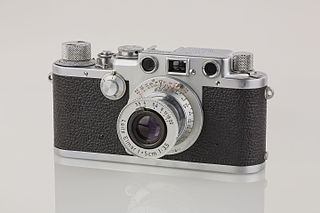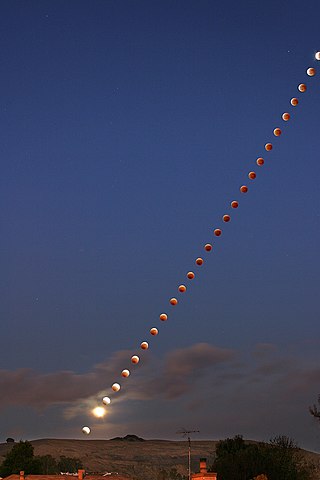Photography is the art, application, and practice of creating durable images by recording light, either electronically by means of an image sensor, or chemically by means of a light-sensitive material such as photographic film. It is employed in many fields of science, manufacturing, and business, as well as its more direct uses for art, film and video production, recreational purposes, hobby, and mass communication.

A camera is an optical instrument that captures images. Most cameras can capture 2D images, while some more advanced models can capture 3D images. At a basic level, most cameras consist of a sealed box, with a small hole that allows light to pass through and capture an image on a light-sensitive surface. Cameras have various mechanisms to control how light falls onto the light-sensitive surface, including lenses that focus the light and a shutter that determines the amount of time the photosensitive surface is exposed to the light.

A pinhole camera is a simple camera without a lens but with a tiny aperture —effectively a light-proof box with a small hole in one side. Light from a scene passes through the aperture and projects an inverted image on the opposite side of the box, which is known as the camera obscura effect. The size of the images depends on the distance between the object and the pinhole.

Ansel Easton Adams was an American landscape photographer and environmentalist known for his black-and-white images of the American West. He helped found Group f/64, an association of photographers advocating "pure" photography which favored sharp focus and the use of the full tonal range of a photograph. He and Fred Archer developed an exacting system of image-making called the Zone System, a method of achieving a desired final print through a deeply technical understanding of how tonal range is recorded and developed during exposure, negative development, and printing. The resulting clarity and depth of such images characterized his photography.

In photography, shutter speed or exposure time is the length of time that the film or digital sensor inside the camera is exposed to light when taking a photograph. The amount of light that reaches the film or image sensor is proportional to the exposure time. 1⁄500 of a second will let half as much light in as 1⁄250.

Film speed is the measure of a photographic film's sensitivity to light, determined by sensitometry and measured on various numerical scales, the most recent being the ISO system. A closely related ISO system is used to describe the relationship between exposure and output image lightness in digital cameras.

Cinematography is the art of motion picture photography.

In photography and cinematography, a multiple exposure is the superimposition of two or more exposures to create a single image, and double exposure has a corresponding meaning in respect of two images. The exposure values may or may not be identical to each other.

A photogram is a photographic image made without a camera by placing objects directly onto the surface of a light-sensitive material such as photographic paper and then exposing it to light.

Time-lapse photography is a technique in which the frequency at which film frames are captured is much lower than the frequency used to view the sequence. When played at normal speed, time appears to be moving faster and thus lapsing. For example, an image of a scene may be captured at 1 frame per second but then played back at 30 frames per second; the result is an apparent 30 times speed increase. Similarly, film can also be played at a much lower rate than at which it was captured, which slows down an otherwise fast action, as in slow motion or high-speed photography.

Spirit photography is a type of photography whose primary goal is to capture images of ghosts and other spiritual entities, especially in ghost hunting. It dates back to the late 19th century. The end of the American Civil War and the mid-19th Century Spiritualism movement contributed greatly to the popularity of spirit photography. Photographers such as William Mumler and William Hope ran thriving businesses taking photos of people with their supposed dead relatives. Both were shown to be frauds, but "true believers", such as Sir Arthur Conan Doyle, refused to accept the evidence as proof of a hoax.

Hans Holzer was an Austrian-American author and parapsychologist. He wrote more than 120 books on supernatural and occult subjects for the popular market as well as several plays, musicals, films, and documentaries, and hosted a television show, Ghost Hunter.

Bruce Springsteen's Video Anthology / 1978–88 is a collection of 18 music videos made on his behalf, released in VHS format on January 31, 1989. In March 1989, "Video Anthology / 1978–88" was certified 3× Platinum by the Recording Industry Association of America (RIAA) for shipment of 300,000 units. As of March 1989, the collection sold 340,000 copies in the United States.

Barbara Blondeau (1938–1974) was an American experimental photographer active in the mid-1960s through the early 1970s. In her career as a photographer, she worked in a wide variety of materials, process and formats, although she is best known for her strip prints which she stumbled upon while shooting with a malfunctioning camera.

Visual Studies Workshop (VSW) is a non-profit organization dedicated to art education based in Rochester, New York, in the Neighborhood of the Arts. VSW supports makers and interpreters of images through education, publications, exhibitions, and collections. VSW houses a bookstore, microcinema, exhibition gallery, and research center, and hosts artists-in-residence.

Ātman is a 1975 Japanese experimental short film directed by Toshio Matsumoto. The film depicts a figure sitting in an outdoor environment and wearing a robe and a Hannya mask. The film features receding and shifting images captured in a frame-by-frame manner; though these shots resemble zooms and pans, they were actually derived from positioning the camera on a series of a points.
Takashi Ito is a Japanese experimental filmmaker known for his avant-garde short films, including Spacy (1981), Thunder (1982), and Ghost (1984), that often make use of long-exposure photography. His style is sometimes compared to that of his mentor Toshio Matsumoto.

Spacy is a 1981 Japanese experimental short film directed by Takashi Ito. The film consists of 700 continuous 16 mm still photographs of a gymnasium; as the camera moves throughout the space in different patterns, easels displaying photographs of the same gymnasium in which they are standing are seen.
Ghost is a 1984 Japanese experimental short film directed by Takashi Ito. As with Ito's shorts Thunder (1982) and Grim (1984), Ghost was shot in 16 mm, features long-exposure photography, and has been characterized as using light, sound, and photographic techniques to create an ominous atmosphere and invoke the feeling of a space haunted by a ghostly presence.
Zone is a 1995 Japanese experimental short film directed by Takashi Ito. It features a headless figure restrained to a chair, surrounded by a ghostly, masked figure, a model train, and other imagery.
















